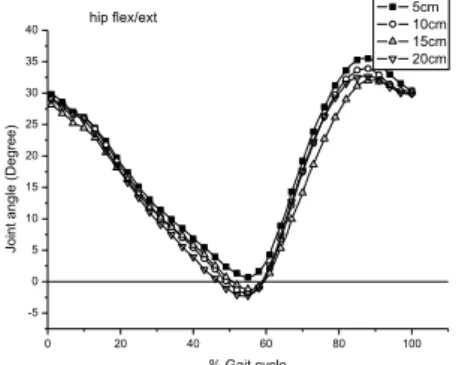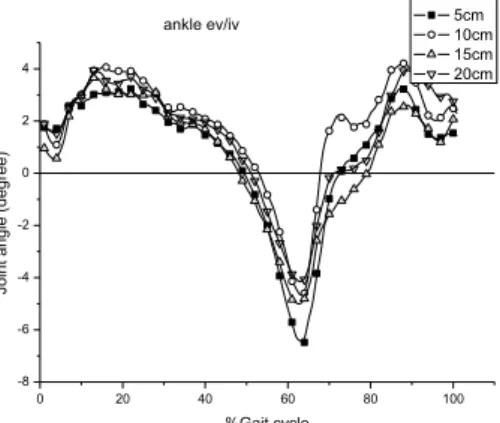THE DIFFERENCE OF BIOMECHANICS ON WALKING STEP WIDTH VARIABILITY
1Yu-Lin You, 2Chien-Fen Lin, 1Fong-Chin Su and 2Lan-Yuen Guo
1
Department of Biomedical Engineering, College of Engineering, National Cheng Kung University, Tainan, Taiwan
2
Department of Sports Medicine, College of Medicine, Kaohsiung Medical University, Kaohsiung, Taiwan Yuen@kmu.edu.tw
SUMMARY
The purpose of this study was to investigate the difference of lower extremity biomechanics on different step width. There were 7 females participated in this study. The mean age was 21.57 (2.64) years old, the mean height was 160.14 (3.80) cm and the mean weight was 53.57 (7.37) kg.
The wider step width showed a greater hip extension and
abduction angle during stance phase. The more narrowed step width showed the more ankle inversion angle.
The wider step width showed the greater reaction force in medial side, hip extensor moment and knee external moment. However, the knee valgus moment was greater during narrow step width walking than the other three step widths. The Narrow step width showed a greater ankle inversion angle and knee valgus moment and relative lesser knee external rotator moment. Thus, the narrow step width may be a helpful gait training manipulation factor for improving PFPS, knee OA and pes planus patients.
INTRODUCTION
Previous study indicated that there’s an association between step width and falls in elderly [1]. Thus, the application of step width on gait training for elderly may improve their dynamic balance during walking.
On the other hands, one of the etiologies of patellofemoral pain syndrome (PSPF) is patella pulled abnormally due to imbalance vastus medialis oblique (VMO) and vastus lateralis [2]. In our preliminary study, the results of electromyography activation levels showed that the VMO activation levels increased during narrow step width walking. To our knowledge, there are few studies investigated the difference of biomechanics between different step width. Thus, the purpose of this study was to investigate the difference of lower extremity biomechanics on different step width.
METHODS
3-D motion analysis system (Qualisys Oqus 100, Qualisys Oqus-CMOS, Qualisys AB, Swenden) and 2 force plates (9286AA,9286A, Kistler Instrument Corp, Winterhur, Switzerland) was used to measure the biomechanical data. There were 7 females participated in this study. The mean age was 21.57 (2.64) years old, the mean height was 160.14 (3.80) cm and the mean weight was 53.57 (7.37) kg.
Subjects were instructed to walk through force plates in 4 different step widths and with a cadence of 96 steps / min. The sequence of step width was randomized, and each step width should perform 3 trials.
RESULTS AND DISCUSSION
In the results of kinematics, the wider step width showed a
greater plantar flexion (Figure 1) during toe off phase and
hip extension (Figure 2) during stance phase. The more narrowed step width showed the more ankle inversion angle (Figure 3). This result may result in an increased arch height. Pes planus patients had a more flat ankle arch and the stability was decreased in this patient group. According to this result, the narrowed step width may be a helpful gait training manipulated factor for improving pes planus patients’ stability. Hip abduction angle was increased when step width increased (Figure 4). The increased hip extension and abduction angle may increase the stress on the posterolateral side on the hip.
In the results of kinectis, the wider step width, the greater reaction force in medial side (Figure 5). This may be because of the fact that the greater ankle eversion angle increased the contact area on medial side of foot. The results of our preliminary study found that the foot pressure was greater on medial side [3]. Hip extensor moment (Figure 6) and knee external moment (Figure 7) was greater with wider step width during late stance phase. However, the knee valgus moment was greater during narrow step width walking than the other three step widths (Figure 8). In previous study, the PFPS runner showed a greater knee external rotation moment than healthy runner. Thus, the wider step width may not suggest to be applied on PFPS patients.
Figure 1: The differences of ankle joint angle in sagittal
plane among four step widths during gait cycle.
Figure 2: The differences of hip joint angle in sagittal plane
among four step widths.
0 20 40 60 80 100 -5 0 5 10 15 20 25 30 35 40 Jo in t a n g le (D e g re e ) % Gait cycle 5cm 10cm 15cm 20cm hip flex/ext 0 20 40 60 80 100 -25 -20 -15 -10 -5 0 5 Jo in t a n g le (d e g re e ) % Gait cycle 5cm 10cm 15cm 20cm ankle df/pf
Figure 3: The differences of ankle joint angle in frontal
plane among four step widths.
Figure 4: The differences of hip joint angle in frontal plane
among four step widths.
Figure 5: The differences of ground reaction force in
mediolateral side among four step widths.
Figure 6: The differences of hip joint moment in sagittal
plane among four step widths.
Figure 7: The differences of knee joint moment in
transverse plane among four step widths.
Figure 8: The differences of knee joint moment in frontal
plane among four step widths.
CONCLUSIONS
The Narrow step width showed a greater ankle inversion angle and knee valgus moment. Thus, the narrow step width used for gait training may improve PFPS, knee OA and pes planus patients.
ACKNOWLEDGEMENTS
This study was supported by Chi Mei Medical Center CLFHR 9729, Taiwan
REFERENCES
1. Heitmann et al., Journal of the American Physical
Therapy Association. 69: 923-931, 1989.
2. Voight et al., Am J Sports Med. 19: 131-7, 1991. 3. Lee et al., Journal of Sports Med Phys Fitness, 11:
1071-1083, 2011.
4. Stefanyshyn et al., Am J Sports Med,34: 1844-1851,
2006 0 20 40 60 80 100 -8 -6 -4 -2 0 2 4 Jo in t a n g le (d e g re e ) %Gait cycle 5cm 10cm 15cm 20cm ankle ev/iv 0 20 40 60 80 100 -4 -2 0 2 4 6 8 10 Jo in t a n g le (D e g re e ) % Gait cycle 5cm 10cm 15cm 20cm hip abd/add 0 20 40 60 80 100 -0.12 -0.10 -0.08 -0.06 -0.04 -0.02 0.00 0.02 G R F (% BW ) % Gait cycle 5cm 10cm 15cm 20cm GRF (M/L) 0 20 40 60 80 100 -0.6 -0.4 -0.2 0.0 0.2 0.4 0.6 Flexor Extensor Extensor Jo in t mo me n t (N -m) Gait cycle (%) 5cm 10cm 15cm 20cm Extensor Hip ex / flex 0 20 40 60 -0.10 -0.08 -0.06 -0.04 -0.02 0.00 0.02 0.04 0.06 0.08 0.10 0.12 0.14 Internal rotation Jo in t mo me n t (N -m) Gait cycle (%) 5cm 10cm 15cm 20cm External rotation
Knee ext / int
0 20 40 60 80 100 -0.5 -0.4 -0.3 -0.2 -0.1 0.0 0.1 0.2 Valgus Jo in t mo me n t (N -m) Gait cycle (%) 5cm 10cm 15cm 20cm Knee valgus / varus

